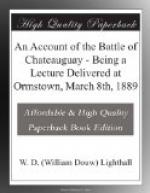Now as to the measures of fortification taken by De Salaberry. In his rear there was a small rapid where the river was fordable in two spots close to one another. He commanded this with a strong breastwork and a guard. There were four ravines which issued from the very thick woods, crossing the road, and distant from each other two hundred yards or so. On their banks he made his men fell trees and build them into breastworks—“a kind of parapet extending into the woods some distance.” To prevent the American cannon from bearing on these breastworks, he felled trees and bush, covering a large stretch of ground with obstructions in the front. The breastwork on the front-line formed an obtuse angle at the right of the road, and extended along the curves of the ravine. The Colonel then sent forward to a spot some distance in advance of the front-line a party of Beauharnois’ axemen, well accustomed to felling trees, who destroyed the bridges and obstructed the road with their fragments and fallen trees and brush. Lieut. Guy, with twenty Voltigeurs, guarded them in front, and Lieut. Johnson, with about the same number, in rear. Working incessantly, these axemen made a formidable series of such obstructions in front of the first line, extending from the river three or four acres into the woods, where they joined an almost impracticable marsh. On the opposite bank of the river De Salaberry also placed a picket of sixty Beauharnois militia under Captain Bruyere, so as to check any advance on the ford, which was his weak point in the rear.
Part of De Salaberry’s line at the abattis, was a small blockhouse on the river-bank (which, however, is not that which has since been reputed to be the one concerned), and the works there blocked the commencement of the wood and looked out on a broadening plain or level of clearings, across which the enemy would have to pass.
The Glengarry men now came down, under McDonell of Ogdensburgh, famous for his adventurous capture of that place, and whose exploit the Salaberry was about to match. Lieut.-Colonel McDonell—“Red George”—was at Prescott drilling a new force of Canadian Fencibles, made up, some say, chiefly of Scotch and loyalists,[20] others chiefly of French boatmen, when Sir George Prevost asked him how soon he could have his men ready to go down to Chateauguay. “As soon as they have done their dinner!” he responded. Within a few hours he had provided them with batteaux, and they were off down the rapids. When Sir George himself, who was on the way, got there, he, to his great surprise found McDonell before him. “Where are your men?” said he. “There,” said the Highland Colonel, pointing to his force resting on the ground—“not a man absent."[21]
For nearly three weeks the parties of Canadian workers worked continually upon the plan of De Salaberry, while Hampton was considering, preparing, reviewing his troops, and arranging for a communication with Wilkinson so soon as the latter should have passed Ogdensburg on his way down the St. Lawrence.




